SEJournal Online is the digital news magazine of the Society of Environmental Journalists. Learn more about SEJournal Online, including submission, subscription and advertising information.
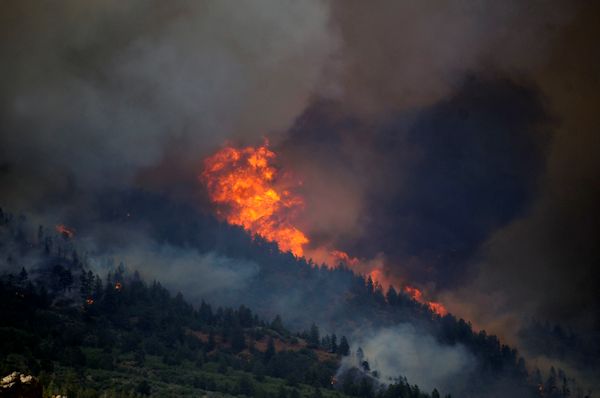 |
| On June 26, 2012, at 3:42 p.m., the Waldo Canyon Fire, which had seemed to be quieting down, exploded over a ridge (above) and raced down into the Mountain Shadows subdivision of Colorado Springs, Colo. High winds and dry conditions created a firestorm that by day’s end took two lives and burned 346 homes to the ground in what up until then was Colorado’s most destructive wildfire. Photojournalist Helen Richardson describes the experience of covering the disaster in her account below. Photo by Helen H. Richardson, The Denver Post. Click to enlarge. |
EJ Insight: ‘I Can’t Not Shoot This’ — For Photojournalist, Preparation Meets Opportunity
By Helen H. Richardson
June 26, 2012, is a day I will never forget.
It was day four of the Waldo Canyon Fire. Colorado Springs was experiencing a record high temperature of 101 degrees. All the journalists had been put on a bus and carted to the other side of the fire for a daily media tour.
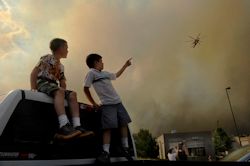 |
| At 4:07 p.m., Caden Manes, 8, at right, and Ryan Kent, 6, with other spectators watch as a Skycrane helicopter makes water drops on the fire as it raced down into the subdivision. Photo by Helen H. Richardson, The Denver Post. Click to enlarge. |
I truly don’t think we could have been taken further away. We had on all of our PPE gear just to prove to someone that we were “safe,” when all we were seeing were a few trucks doing mop-up where the fire had burned through two to three days before.
When this “sideshow” was over, we were taken back to downtown Colorado Springs. As we neared the media staging area, we all started to look out the window and watched in horror as the fire turned into a firestorm before our eyes.
A thunderstorm in the area created erratic winds coming from the west with gusts nearing 65 mph. We watched as the fire crested Queen’s Canyon and raced down into Mountain Shadows, Oak Valley Ranch and Peregrine neighborhoods, fire activity rarely seen.
Everyone ran to their cars to figure out how to cover this unfolding event.
‘Chaos reigned’
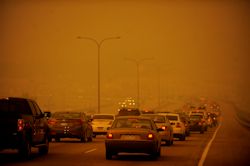 |
| At 4:56 p.m., a traffic jam of cars heading north on Interstate 25 flees Colorado Springs as it is enveloped by an orange haze of smoke caused by the rapidly growing fire. Photo by Helen H. Richardson, The Denver Post. Click to enlarge. |
I drove as fast as I could to get as close as I could to the fire to shoot as many photos as possible. People on the streets watching the fire race down from the ridge, helicopters racing madly to make water dumps on the fire as fast as they could, the enormous plume forming directly above.
It was hectic but seemingly under control. People were not panicking … yet.
But as the weather shifted and the heat of the day increased, the cyclonic winds from the thunderstorm caused the collapse of the enormous pyrocumulus cloud and covered the entire city in an orange layer of smoke and ashes.
Chaos reigned. The fire was moving about 2 mph. Embers were carried by the wind to a distance of up to a quarter-mile away and caused multiple small spot fires of brush and low vegetation.
Once the fire crossed into neighborhoods, the fuel for the fire became houses and the fire quickly spread from house to house. Within the time span of the next twelve hours, 346 homes would burn to the ground.
‘Something I never imagined I would ever see’
Panic ensued and everyone started to flee the city. I had never been in a situation like this before. I got caught up in the traffic and definite fear, and decided I needed to make my way north out of the city.
I was thinking “Well, this is crazy. I have photos of the fire. I should just go back to Denver to file my photos. I don’t need to stay. It isn’t safe.”
But listening to the radio, I heard speculation of homes burning, many homes burning. I made my way up to the Air Force Academy and pulled over. The huge plume of smoke from the fire’s blow-up was billowing overhead, blotting out the sun.
Again, I thought to myself, “Slow down. Just think about this. This is a big news story happening. You need to go back to see what you can get. . . I can’t not shoot this.”
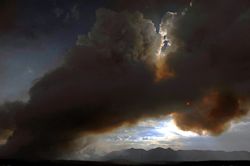 |
| At 5:40 p.m., the huge column of smoke rising from the fire forms a pyrocumulus cloud that blocks out the sun as the fire raced over two miles northward onto the Air Force Academy land. Photo By Helen H. Richardson, The Denver Post. Click to enlarge. |
I think the photo gods were with me that day.
As I was heading back toward the fire, everyone was leaving, so I was able to make it to the exit that I thought would take me closest to the fire. Somehow, I was able to get by sheriff’s deputies, as they directed people out of the city, by turning into a grocery store parking lot. I went through the lot and came to an opening on the other end.
All the cars were going right, away from the fire. I turned left and found myself completely alone. No cars on the road and, to my disbelief, a wide-open road heading right towards the fire.
I thought to myself that I had better move quickly and get off this main road before I get stopped. I pulled into a neighborhood, and drove as far as I could to get as close as I could to where it looked like the fire was.
There was smoke everywhere. I was definitely nervous. I tried to stay calm, telling myself, “Don’t speed. Don’t get stopped by the police. Don’t wreck your car.”
I parked in an area between two homes at the bottom of a hill. I hiked up the hill and was shocked at what I saw before me.
As I crested that hill, what unfolded in front of me was something I never imagined I would ever see: An entire neighborhood of homes fully engulfed in flames. I couldn’t believe my eyes.
A night spent watching hundreds of homes burn
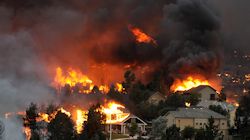 |
| At 7:12 p.m., dozens of houses burn — almost the entire neighborhood of the Mountain Shadows subdivision. Urban conflagrations like this were rare at the time, so when this picture was circulated worldwide by Getty Images, it made the front pages of both the New York Times and Paris Match, garnering over 48 million views. Photo by Helen H. Richardson, The Denver Post. Click to enlarge. |
I stayed the entire night on the ridge because I knew once I left there was no way I was getting back in.
And if I was caught inside the fire, I risked getting in a lot of trouble. Part of photographing wildland fires is staying safe and not getting either arrested or booted from the area.
I was able to go up and down the hill that night to keep all my gear fully charged and get my computer out of my car to file my photos by personal cellular hotspot from the top of the ridge.
And one of them that went out on Getty made front pages worldwide (The New York Times, Paris Match), ultimately garnering over 48 million views.
I had had no idea at the beginning of the day that I would be spending the night on a ridge watching hundreds of homes burn.
Because I had food and water in my car, warm clothes (even during fires, nights can get cold), an AC power inverter that was able to charge my phone and my computer, and a full tank of gas to keep the car running, I was able to stay as long as needed, and, more importantly to be able to keep shooting.
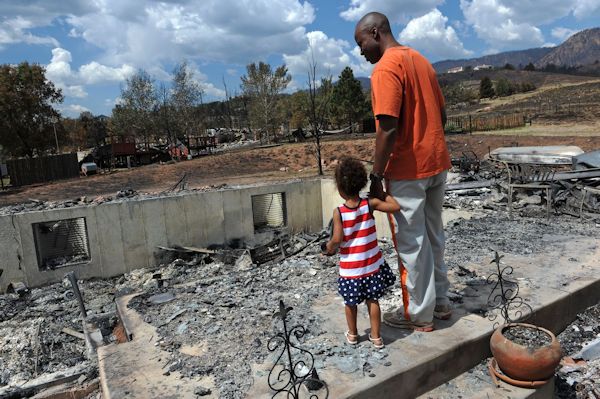 |
| Immanuel Mgana (above), a U.S. Army soldier deployed in eastern Africa, saw Richardson’s image and recognized that one of the homes burning was his own (shown in the 7:12 p.m. photo, above right. Mgana's home is at the bottom, center, with car in driveway). He was immediately granted leave to return home to his wife and three children. Five days after the Waldo Canyon Fire ravaged their neighborhood, residents were allowed back in to see if their homes were lost or still standing. Over 340 homes were lost in this subdivision, while others, sometimes next door, were left untouched. Here, on July 1, Mgana holds the hand of his daughter Grace, 2, as they survey what is left of their home. It was a total loss. Photo by Helen H. Richardson, The Denver Post. Click to enlarge. |
[Editor’s Note: Also see Richardson’s story about being prepared and staying safe as a wildfire photojournalist in the era of COVID-19.]
Helen H. Richardson is a staff photographer at The Denver Post. As a photojournalist, Richardson has covered large breaking news stories, including the Sept. 11 terrorist attacks on the World Trade Center and the Pentagon, the 2004-05 tsunami in Indonesia and Thailand, the death of Pope John Paul II in Rome and the effects of AIDS and lack of water in African nations. In Colorado, she covers news and sports and specializes in wildfire coverage. She particularly enjoys stories that converge with her interests, which include rock and ice climbing, extreme sports, nature, animals and the environment.
* From the weekly news magazine SEJournal Online, Vol. 5, No. 28. Content from each new issue of SEJournal Online is available to the public via the SEJournal Online main page. Subscribe to the e-newsletter here. And see past issues of the SEJournal archived here.













 Advertisement
Advertisement 



